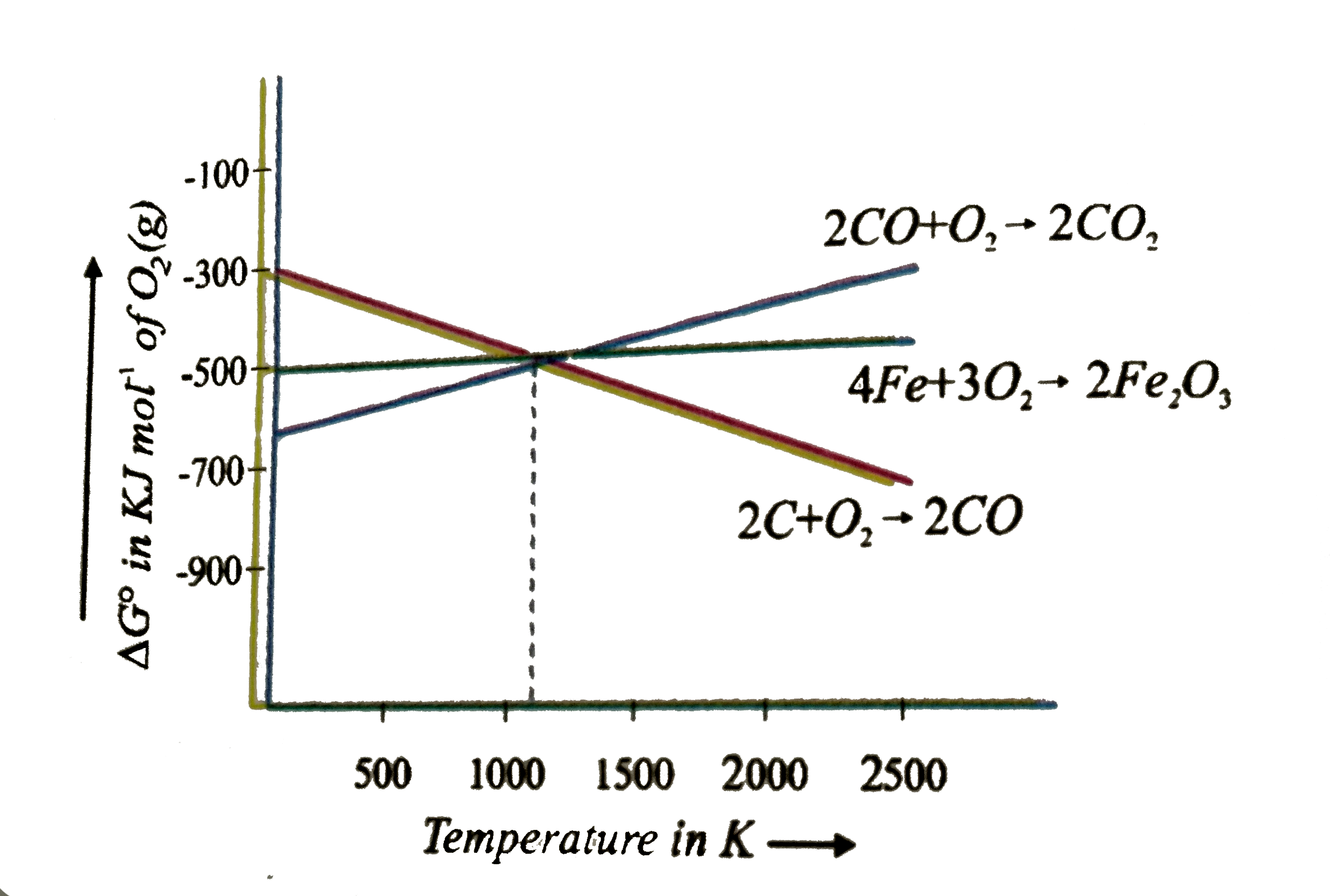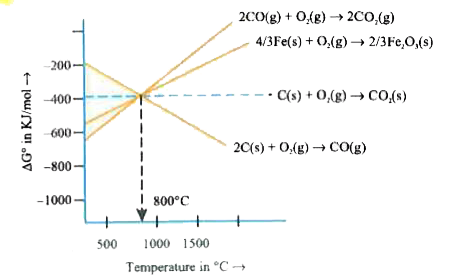Carbon cannot reduce Fe2O3 to Fe at a temperature below 983 K becauseSolution in Odia
free energy change for the formation of CO is more negative than that of Fe2O3
CO is thermodynamically more stable than FeO3
carbon has higher affinity towards oxygen than iron
iron has higher affinity towards oxygen than carbon
The correct Answer is:D
iron has higher affinity towards oxygen than carbon
Topper's Solved these Questions
- GENERAL PRINCIPLES AND PROCESSES OF ISOLATION OF ELEMENTS BOOK - ARIHANT PUBLICATIONCHAPTER - GENERAL PRINCIPLES AND PROCESSES OF ISOLATION OF ELEMENTS EXERCISE - PART II THERMODYNAMIC AND ELECTROCHEMICAL PRICIPLES OF METALLURGY (QUESTIONS FOR PRACTICE) Very Short Answer Type Questions
9 Videos
- GENERAL PRINCIPLES AND PROCESSES OF ISOLATION OF ELEMENTS BOOK - ARIHANT PUBLICATIONCHAPTER - GENERAL PRINCIPLES AND PROCESSES OF ISOLATION OF ELEMENTS EXERCISE - PART II THERMODYNAMIC AND ELECTROCHEMICAL PRICIPLES OF METALLURGY (QUESTIONS FOR PRACTICE) Short Answer Type I Questions
13 Videos
- GENERAL PRINCIPLES AND PROCESSES OF ISOLATION OF ELEMENTS BOOK - ARIHANT PUBLICATIONCHAPTER - GENERAL PRINCIPLES AND PROCESSES OF ISOLATION OF ELEMENTS EXERCISE - PART I EXTRACTION AND ISOLATION OF ELEMENTS (QUESTIONS FOR ASSESSMENT) Long Answer Type Questions
4 Videos
- F-BLOCK ELEMENTS BOOK - ARIHANT PUBLICATIONCHAPTER - F-BLOCK ELEMENTS EXERCISE - CHAPTER PRACTICE (LONG ANSWER TYPE QUESTIONS)
2 Videos
- GROUP 16 ELEMENTS: OXYGEN FAMILYBOOK - ARIHANT PUBLICATIONCHAPTER - GROUP 16 ELEMENTS: OXYGEN FAMILYEXERCISE - CHAPTER PRACTICE (LONG ANSWER TYPE QUESTIONS)
2 Videos
Similar Questions
Out of C and CO, which is a better reducing agent at 673 K?
View SolutionThe choice of a reducing agent in a particular case depends on the thermodynamic factor. How far do you agree with statement? Support your opinion with two examples.
View SolutionAnswer the question:
Name the process in which no external reducing agent is used.
View Solution(i) What is the effect of lanthanoid contraction on the chemistry of the lanthanoids?
View SolutionComplete the following reactions:
(a) NaOH+SO2→
(b) COOH∣COOH+H2SO4→
(c) BaO2+O3→
(d) PbS+O3→
(e) I2+O3+H2O→
View SolutionCarbon monoxide is more effective reducing agent than carbon below 983K but above this temperature, the reverse is true. How would you explain this ?
View SolutionCabon cannot reduce Fe2O3 to Fe at a temperature below 983K because.
View SolutionReduction of Fe2O3 with CO is done below 710∘C.
ΔfGӨ is negative at this temperature , this process is spontaneous.
View SolutionCorrect statements from the graph

I) Above 1073 K,ΔG0 for the formation of F2O3 is less negative than ΔG0 for the formation of CO from carbon
II) Above 1073K, Carbon can reduce Fe2O3
III) Below 1073K, CO can reduce Fe2O3
IV) In blast furnance, reduction of Fe2CO3 occurs in different temperature ranges with below 1073K by CO (or) above 1073 K by carbon
View SolutionIn the extraction of Fe from Fe_(2)O_(3) the reducing agent is
View SolutionAbove 1073 K, ………… reduces FeO to Fe while below 1073K, …………… reduces Fe_ 2 O _ 3 to Fe.
View SolutionUsing the Ellingham diagram given below.
It is possible to reduce Fe2O3 by coke at a at temperature around 1200 K.
View SolutionCorrect statements form the graph

I) Above 1073K, ΔG0 for the formation of Fe2O3 is less negative than ΔG0 for the formation of CO from carbon
II) Above 1073K, Carbon can reduce Fe2O3
III) Below 1073K, CO can reduce Fe2O3
IV) In blast furnace, reduction of Fe2O3 occurs in different temperature ranges with below 1073K by CO (or) above 1073K by carbon
View SolutionCarbon monoxide is more effective reducing agent than carbon below 983 k but, above this temperature, the revere is true -Explain.
View SolutionCarbon can reduce ferric oxide to iron at a temperature above 983 K because
View SolutionCarbon can reduce ferric oxide to iron at a temperature above 983 K because
View Solution
